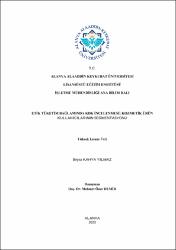| dc.contributor.advisor | Demir, Mehmet Özer | |
| dc.contributor.author | Kahya Yılmaz, Beyza | |
| dc.date.accessioned | 2023-10-26T08:31:50Z | |
| dc.date.available | 2023-10-26T08:31:50Z | |
| dc.date.issued | 2023 | en_US |
| dc.date.submitted | 2023-08-15 | |
| dc.identifier.uri | https://hdl.handle.net/20.500.12868/2428 | |
| dc.description.abstract | Grunig’in iletişim davranışına ilişkin durumsal teorisi, insanların neden iletişim
kurduklarını ve ne zaman iletişim kurduklarını açıklamaya çalışmaktadır. Kamuların
durumsal kuramı, iletişimin davranışsal etkilerinin yanı sıra, bu sonuçların en olası
olduğu belirli iletişim türleri ve kamu türleri ile en yaygın şekilde bağlantılı olan tutumları
da tahmin etmektedir. Bu çalışmada da kamuların durumsal kuramından yola çıkılarak,
kozmetik ürün kullanıcılarının segmentasyonu hakkında bilgi edinilmesi amaçlanmıştır.
Son yıllarda özellikle kozmetik sektöründe büyük bir değişim yaşanmaktadır. İnsanlar,
kozmetik ürünlerin tercih edilmesinde ve satın alma niyetlerinde, farklı faktörlerden
etkilenmektedir. Bu durum, kamuların durumsal kuramı ile kamunun farklı
segmentasyonda olduğunu göstermektedir.
Bu bağlamda, 418 katılımcı ile ilişkisel tarama tekniği kullanılarak nicel bir
araştırma gerçekleştirilmiştir. Kamuların durumsal kuramının değişkenlerinden sorun
algısı, kısıt algısı, ilgilenim ve referans kriteri ile durumsal motivasyon ve satın alma
niyeti boyutlarına ilişkin anket formu oluşturulmuştur. Araştırmada frekans analizlerinin
dışında, korelasyon ve path (yol) analizi gerçekleştirilmiştir. Analizlerin
gerçekleştirilmesinde SPSS ve Amos programlarından yararlanılmıştır. Sorun algısı, kısıt
algısı, ilgilenim ve referans kriterinin davranışsal motivasyonu etkileyeceği ve sonuç
olarak satın alma niyetinde bu durumun etkili olacağı şeklinde araştırma modeli
oluşturulmuştur. Elde edilen bulgular, araştırma kapsamında incelenen boyutlar arasında
pozitif ve istatistiksel olarak anlamlı bir ilişkinin olduğu yönündedir. Ayrıca path
analizine göre, sorun algısı, kısıt algısı, ilgilenim, referans kriteri davranışsal
motivasyonu etkilemekte ve sonuç olarak satın alma niyeti etkilenmektedir. | en_US |
| dc.description.abstract | Grunig's situational theory of communicative behavior attempts to explain why
and when people communicate. Situational theory of publics predicts the behavioral
effects of communication, as well as the attitudes most commonly associated with the
particular types of communication and types of publics for which these outcomes are most
likely. In this study, it is aimed to obtain information about the segmentation of cosmetic
product users based on the situational theory of publics. In recent years, there has been a
great change especially in the cosmetics industry. People are affected by different factors
in the choice of cosmetic products and their purchase intentions. This shows that the
situational theory of publics and the public are in different segmentation.
In this context, a quantitative research was conducted with 418 participants using
the relational survey technique. A questionnaire form was created on the variables of the
situational theory of publics, such as problem perception, constraint perception,
involvement and reference criteria, and situational motivation and purchase intention
dimensions. In the study, apart from frequency analysis, correlation and path analysis
were performed. SPSS and Amos programs were used in the analysis. A research model
has been created that problem perception, constraint perception, involvement and
reference criteria will affect behavioral motivation and as a result, this will be effective
in purchasing intention. The findings show that there is a positive and statistically
significant relationship between the dimensions examined within the scope of the
research. In addition, according to path analysis, problem perception, constraint
perception, involvement, reference criteria affect behavioral motivation and as a result,
purchase intention is affected. | en_US |
| dc.language.iso | tur | en_US |
| dc.publisher | Alanya Alaaddin Keykubat Üniversitesi / Lisansüstü Eğitim Enstitüsü | en_US |
| dc.rights | info:eu-repo/semantics/openAccess | en_US |
| dc.subject | Kamuların durumsal kuramı | en_US |
| dc.subject | Kozmetik sektörü | en_US |
| dc.subject | Segmentasyon | en_US |
| dc.subject | Situational theory of publics | en_US |
| dc.subject | Cosmetics industry | en_US |
| dc.subject | Segmentation | en_US |
| dc.title | Etik Tüketim Bağlamında KDK İncelenmesi: Kozmetik Ürün Kullanıcılarının Segmentasyonu | en_US |
| dc.title.alternative | Situational Theory of the Public in the Context of Ethical Consumption: Segmentation of Cosmetic Product Users | en_US |
| dc.type | masterThesis | en_US |
| dc.contributor.department | ALKÜ, Enstitüler, Lisansüstü Eğitim Enstitüsü, İşletme Mühendisliği Ana Bilim Dalı | en_US |
| dc.relation.publicationcategory | Tez | en_US |


















